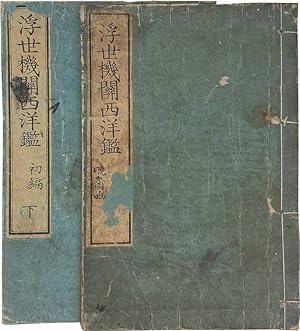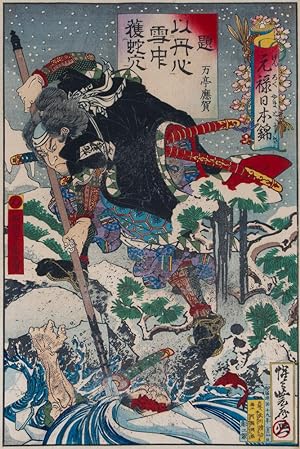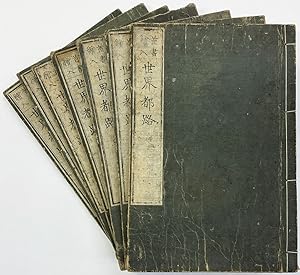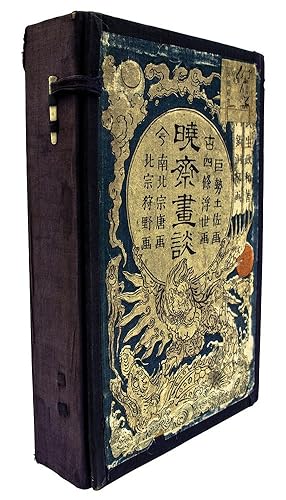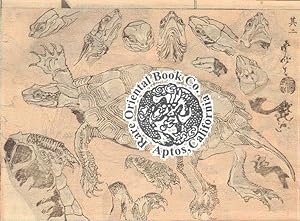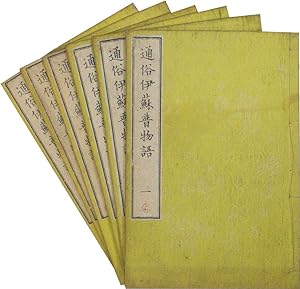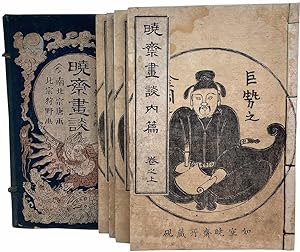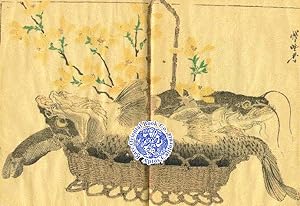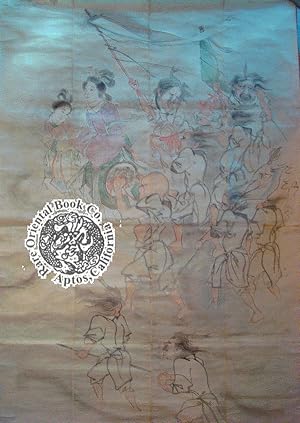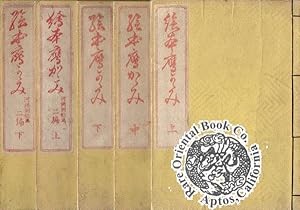kawanabe kyosai (25 Ergebnisse)
Produktart
- Alle Product Types
- Bücher (24)
- Magazine & Zeitschriften
- Comics
- Noten
- Kunst, Grafik & Poster (1)
- Fotografien
- Karten
- Manuskripte & Papierantiquitäten
Zustand
Einband
Weitere Eigenschaften
- Erstausgabe (4)
- Signiert
- Schutzumschlag
- Angebotsfoto (18)
Gratisversand
- Versand nach USA gratis
Land des Verkäufers
Verkäuferbewertung
-
Kyosai
Verlag: Royal Academy of Arts 2022-02-28, London, 2022
ISBN 10: 1912520745ISBN 13: 9781912520749
Anbieter: Blackwell's, London, Vereinigtes Königreich
Buch
hardback. Zustand: New. Language: ENG.
-
La Procession des cent démons
Verlag: PICQUIER, 2023
ISBN 10: 2809716390ISBN 13: 9782809716399
Anbieter: Gallix, Gif sur Yvette, Frankreich
Buch
Zustand: Neuf. KYOSAI, Kawanabe (illustrator).
-
[Warabi 2015, Kawanabe Kyosai Memorial Museum]. Stiff color pictorial wrs.,A NEW copy, 14.7 x 21 cm., many photos, 63p., Japanese text, some English, bibliography of Kyosai related books. * * FIRST & ONLY SMALL EDITION * * . *** *** *** . . . FIRST AND ONLY SMALL LIMITED EDITION . . . . CELEBRATING KYOSAI'S 125 YEAR ANNIVERSARY 1831-1889 . . VOLUME 1 OF 2 . * The Kawanabe Kyosai Memorial Museum exhibition catalog covers Kyosai paintings, woodblock prints, Ehon [woodblock printed books], sketches, paintings and other studies. . With an excellent biography of Kyosai. With copious bibliography of recommended books and exhibition catalogs about him. With a list of his exhibition history. . * A very useful, well-illustrated reference. Showing Kyosai's brilliance, creativity, macabre side, humor, Samurai, devils, skeletons and many other fascinating sketches, books & prints. * . *** Color photos are posted to our website. . Please visit our website to see other items by or about Kyosai. . *.
-
[Warabi 2015, Kawanabe Kyosai Memorial Museum]. Stiff color pictorial wrs., A NEW copy, 14.7 x 21 cm., 85 color, 31 b.w. photos, 63p., Japanese text, some English, bibliography of Kyosai related books. * * FIRST & ONLY SMALL EDITION * * . *** *** *** . . . FIRST AND ONLY SMALL LIMITED EDITION . . . . CELEBRATING KYOSAI'S 125 YEAR ANNIVERSARY 1831-1889 . . VOLUME 1 OF 2 . * The Kawanabe Kyosai Memorial Museum exhibition catalog covers Kyosai paintings, woodblock prints, Ehon [woodblock printed books], sketches, paintings and other studies. . With an excellent biography of Kyosai. With copious bibliography of recommended books and exhibition catalogs about him. With a list of his exhibition history. . * A very useful, well-illustrated reference. Showing Kyosai's brilliance, creativity, macabre side, humor, Samurai, devils, skeletons and many other fascinating sketches, books & prints. . * With Hanko [seal/chop] examples. . *** Color photos are posted to our website. . Please visit our website to see other items by or about Kyosai. . *.
-
This is Kyosai! The Israel Goldman Collection.
Anbieter: Antiquariaat A. Kok & Zn. B.V., Amsterdam, Niederlande
Tokyo, The Tokyo Shimbun, 2017. 285 pp. Col. & b./w. ills. Orig. hardcover. (Text in Japanese & English).Kawanabe Kyosai, a renowned Meiji artist, was known for his dual identity as a drinker and genius. As a painter and printmaker, he delved into the realms of the weird, the comic, and the obscure. Belonging to the transitional period from Edo to Meiji, he witnessed the shift from the Middle Ages to a Modern Industrialized Society, contributing significantly to the evolution of ukiyo-e art.
-
Tokyo, The Tokyo Shimbun, 1996. 330 pp. Col. & b./w. ills. Orig. softcover. (Text in Japanese & English).Kawanabe Kyosai, a renowned Meiji artist, was known for his dual identity as a drinker and genius. As a painter and printmaker, he delved into the realms of the weird, the comic, and the obscure. Belonging to the transitional period from Edo to Meiji, he witnessed the shift from the Middle Ages to a Modern Industrialized Society, contributing significantly to the evolution of ukiyo-e art.
-
Nihon no Yurei Meigashu
Verlag: Tokyo: Jinrui Bunka-sha, 2000
ISBN 10: 4756711936ISBN 13: 9784756711939
Buch Erstausgabe
Hardcover. Zustand: Near Fine. 1st Edition. A first edition, first printing copy of this compilation of famous paintings and woodblock prints of ghouls by famous Japanese artists. The text includes contributions from Japanese literary figures such as `yokai` specialist Komatsu Kazuhiko, literary critic Higashi Masao, and `Gegege no Kitaro` author and artist Mizuki Shigeru. Text in Japanese. 1 v. (complete). 36.4 x 25.8cm. 167 p. With 75 colour plates of the famous works included. Comes with original dust jacket, slipcase, and shipping box (complete with obi). Hardcover. Shipping box with corners a little bumped, obi with a few small tears to extremities. Book, dust jacket and slipcase in near fine condition. May require extra shipping due to size and weight.
-
L'HISTOIRE ILLUSTREE DES CENT DEMONS
Verlag: ATELIER DE BIBLIOPHILIE POPULAIRE, 2010
ISBN 10: 2360680129ISBN 13: 9782360680122
Anbieter: Librairie SSAD, Bussigny, Schweiz
Buch
Couverture rigide. Zustand: Bon. legère usure de l'enveloppe.
-
Tokyo 1987, Riccar. Purple stiff wrs., NEW, UNUSED, 110p.,32 color, 119 b.w. plates, 15 figures, Japanese & English list & exhibit summary, ca. 21 x 30 cm., a crisp & clean example. * * FIRST & ONLY RARE EDITION * * . *** **** *** . . A SUPERBLY ILLUSTRATED REFERENCE . . . LISTING & ILLUSTRATING A 152 FINE EXAMPLES OF KYOSAI . . . WOODBLOCK PRINTED BOOKS, PRINTS & OTHER GRAPHIC ITEMS . . * Excellent and valuable monograph on one of the Meiji period's most unusual, creative & most imaginative print artists. His magnificent woodcut prints and illustrated books, drawings and manuscripts have fascinated collectors and curators for years. years. His diversity and pure imagination of demons and devils is unprecedented, and unsurpassed. . An exceptionally useful reference for any collector, student or curator of Kyosai. . *** This copious reference book illustrates and discussing almost everything published plus a large percent of his drawings and resulting prints. This work is therefore the closest thing to a "Catalogue Raisonne" on Kyosai to date. . Among some of the great entries, are the illustrations and references to his stunning and high-water mark set of three illustrated wood-cut illustrated books on falconry: EHON TAKAKAGAMI: MIRROR OF FALCONRY. . Please visit our website to see a copy of this stunning work. You can also download or request our latest color illustrated e-catalog of items by and about Kawanabe Kyosai. . . *** Color photos are posted to our website. . *** REFERENCE: . L. Roberts: DICTIONARY OF JAPANESE ARTISTS p.100. * BUCKLAND, Rosina. et al. A JAPANESE MENAGERIE: Animal Pictures of Kawanabe Kyosai. * Josiah Conder: PAINTINGS AND STUDIES, Tokyo 1911. . *.
-
KACHO E: SUITE OF FOUR BIRD & FLOWER COLOR WOODBLOCK PRINTS.
Anbieter: RARE ORIENTAL BOOK CO., ABAA, ILAB, Aptos, CA, USA
[Tokyo] 1900-1920, [Nishimiya].Four color woodcut prints,all bright & exceptionally clean, 12.3 x 24.5 cm., matted, one signed,all with two cinnabar Hanko seals, beautifully pastel colored. FIRST AND ONLY EDITION . *** **** *** . . A TENDER SUITE OF FOUR JAPANESE BIRD & FLOWER . . . COLOR WOODBLOCK PRINTS . . * KAWANABE Kyosui [1868-1935, was the daughter of the famous master painter, woodblock print & book illustrator KAWANABE Kyosai/Gyosai [1831-89]. Kyosui learned the art of painting at her father's side. Although Kyosui was not be as well-known as her father nevertheless she was a prolific painter who helped pave the way for other women artists in early 20th-century Japan. . She loved nature and drew, painted and sketched many "Kacho" [Bird & Flower] examples. Her paintings & color woodblock prints displayed her sensitive, naive charm, reflecting a love of nature. Her prints depicted "Kacho" in tender pastel colors, with excellent composition. . *** An article about Kyosui by Gordenker: . "Kyosai's daughter.is hardly known, despite the fact that she worked as a professional artist for many years and advocated effectively for increased opportunities for women in art. Kyosui learned to paint and draw largely from her father, and specialized in many of the same genres, including devotional Buddhist paintings, images of beautiful women, and scenes from Noh and Kyogen plays. She taught Japanese painting at the first institution in Japan to offer formal art education to women, now the Joshibi University of Art and Design." See citation below. . *** THE GROUP OF FOUR COLOR WOODBLOCK PRINTS: . Each print is stamped with the two artist's Hanko [chop/seal] in red cinnabar ink. Print number 1 is signed by the artist in block. . Each print is in a paper mat, with penned title captions & artist name on the inside, with Mylar protectors. The Mylar protector inside each mat has been removed for photographing and then replaced. . Each being in a mat the edges are cropped out in our photographs, the true size of each is indicated below. NOTE: all edges clean and pristine, the size of each print is larger than the scanned images posted to our website: . 1. BUSH CLOVER AND SPARROW 2. PARROT 3. MEIJIRO AND CHERRY BLOSSOMS 4. SPARROW AND COLUMBINE . On the back of print each print is found Nishimiya, the publisher's stamp. . Each print is ready for framing and display. . *** CONDITION: The prints are in excellent condition, lightly tipped in at the top corners. Each example is exceptionally clean, pristine and without marks or issues. . Please see color images posted to our website. . *** BIBLIOGRAPHY: . L. Roberts: DICTIONARY OF JAPANESE ARTISTS, cites the father Kyosai, p.100. Sadly, Roberts does not list Kyosui. * CORTAZZI, Hugh.: IMAGES OF JAPAN 1885-1912: Scenes, Tales and Flowers, see p.32, he cites her * Article by: GORDENKER, Alice: LEGACY OF GENIUS: Kyosai and Kyosui. In the Japan Times, APR 17, 2018: *ttps://www.japantimes.co.jp/culture/2018/04/17/arts/legacy- genius-kyosai-kyosui/#.XPAgQfxS92E . *** .
-
Irimasu Seizan [A Playful Print by Kyosai and Katsubunsai]
Verlag: Tokyo: Fukuda Kumajiro, [ca. Meiji 15-25 (1880s)]., 1880
Kunst / Grafik / Poster
No Binding. Zustand: Very Good. This humorous collaborative work between Kawanabe Kyosai (1831-1889) and Katsubunsai Chingetsu (1835-1908) depicts the gods of commerce counting "countless" things". Katsubunsai, a friend of Kyosai and Shibata Zeshin, was an artisan of "craft paintings" called oshi-e zaiku, pictures made by wrapping thick pieces of paper in various fabrics and pasting them to a board. This triptych displays a playfulness born from the collaboration between friends. Triptych, complete. Light stains and minor wear. Overall very good to near fine. Each print measures 37 x 25 cm. Text in Japanese. .
-
Soft cover. Zustand: Near Fine. This physics textbook, printed in two volumes, provides explanations of Western astronomy, meteorology, and so on, for children. The explanations are accompanied with many comical black and white woodblock-printed illustrations designed by the famous artist Kyosai. While the two books are subtitled First Part , no other parts were published, making this set complete. Original wrappers. Ex-ownership stamps to leaves. Extremely minor stains, otherwise near fine. First part in 2 v., complete. 33, 44 leaves. 18.2 x 12.3 cm. Text in Japanese.
-
Kyosai Gadan [2 out of 4 volumes of Kyosai's Treatise on Painting]
Verlag: Published by Inagaki Buhachi, Tokyo, 1887
Anbieter: Keoghs Books, Skipton, Vereinigtes Königreich
Verbandsmitglied: PBFA
, two volumes, 39 unpaginated leaves, instructions on painting styles with examples from different Japanese artists, woodcuts printed on hand-made Washi paper, many coloured, in Japanese and English First Editions , light wear to edges, one volume disbound, light marking to wraps, covers creased in places, pages and illustrations clean, good condition , stitched cream wraps with printed illustrations and titles in Japanese , 25.5 cm x 17.5 cm Paperback ISBN:
-
Soft cover. Zustand: Very Good. Kawanabe Kyosai's early satirical work "Confusion and awkwardness of westernization" is a two volume set describing the downsides of Western culture in comical scenes. The book is criticizing Meiji policy regarding the assimilation of European customs and wear. Complete set of the first part, second part never been published. Text in Japanese. 2 volumes complete. 18.3x12cm, 21 & 22 leaves. 1 coloured double-page, 1 coloured single-page and 7 b&w single-page illustrations. Brown stain and occasional worm holing on the top edge of the first volume. Original Japanese fukuro toji bindings with the title slips. Spine worn. Wrappers stained and soiled. Back cover of the second volume was covered with red ink inscriptions and washed. Very good condition.
-
Samurai Warrior Horibe Yasube Taketsuna.
Erscheinungsdatum: 1886
Anbieter: Henry Sotheran Ltd, London, Vereinigtes Königreich
Original woodblock, from the series "Japanese Brocades from Gonraku Period," printed in Japan, 1886. 590 x 420 mm. (Size includes mount).
-
Sekai Miyakoji
Verlag: Tokyo: Bankyukaku: Ejima Kihei [publisher], Meiji 5 [1872]., 1872
Buch Erstausgabe
Soft cover. Zustand: Very Good. 1st Edition. A set of books on the history, customs, geography, and natural environments of Asia, Eastern Europe, Western Europe, North Africa, South Africa, and Australia, delicately illustrated in woodcuts by acclaimed Japanese artist Kawanabe Kyosai (1831-1889). As the description of the volume on Australia (v.7) held at the State Library of N.S.W. states, "The depiction of the Aboriginal Australian characters appears as a generic depiction of dark skinned people; for example, the figures are set before pyramids (African continent), and one of the figures is shown holding what appears to be a human foot. The figures are negatively referred to in a caption as 'drunk'." Includes six colour woodblock-printed maps, as well as many more black-and-white woodblock-printed vignettes. A very interesting if tenuous link between Kyosai and Australia/ New Zealand. Volume 7 only is held by the State Library of New South Wales. Original Japanese fukuro toji binding, paper wrapper, with original title slip. Occasional rubbing on the wrapper. Minor stains and faint creasing on the contents. ​​Overall very good to near fine condition. 7 v., complete. 22,5 x 15,1 cm. 52, 45, 46, 40, 38, 26, 17 (+ 10 of advertisements) leaves. Text in Japanese.
-
[Tokyo 1887, Iwamoto]. Stitched orange wrs., 4 volume set, English subtitles, covers a bit dusty, scuffed, a minor bit of old worming, else contents very clean, solid and firm in cloth case, complete set of 4, 17.5 x 25.5 cm. FIRST EDITION . *** **** *** . . . KYOSAI'S SUI GENERIS . . . HIS MOST FAMOUS BOOK OF "PAINTING STYLES" . . . . PROFUSELY COLOR ILLLUSTRATED WOODBLOCK PRINTED . . . COMPLETE SET OF 4 VOLUMES . . * Profusely illustrated by woodblock printing, in color & Sumi, some illustrations are delicately hand-tinted in pastel gouache. A marvelous work with examples of the various "schools" of Japanese [& Chinese style] painting, of well-known artists. . Includes instruction in the art & genealogies of painters, etc. Also an interesting portion illustrating various incidents of Kyosai's life. . * THE ARTIST: KAWANABE KYOSAI [1831-1889]: . Kyosai was a Japanese artist, in the words of a critic, "an individualist and an independent, perhaps the last virtuoso in traditional Japanese painting." . "Kyosai was a Kano painter, printmaker, illustrator, son of a Samurai. Studied under the great Utagawa Kuniyoshi, then later under Maemura Towa and Kano Tohaku Chinshin, who gave him the name Toiku when he was 19. Lived and worked in the Hongo area of Edo [old Tokyo]. Said to have done some of his best work while under the influence of Sake. Exhibited in Vienna International Exhibition in 1873, and again in Paris in 1883. A distinguished painter, marked by a wild, eccentric humor, left many sketches of great dexterity and draftsmanship, and superb copies of other artist's work not as a form of fake or forgeries, but in tribute to their great talent and style. This book for example is a tribute to a grand number of other artists, their style, and to his own unique style of drawing. A marvelous artists and well collected by world museums, institutions and private collectors. His sense of humor is unmatched, and his ability to express his feelings in drawings was superb ! See Roberts below. . *** This work shows a large variety of his works, Buddhist themes & saints, Zen monks, Kannon, Monks, Bodhi Dharma, Buddhist temple Demons, temple & shrine protectors, Gods, icons & holy images. . Military, Samurai, warriors, swords, battle scenes, horses & armor. Edo period genre of ordinary people, landscapes, animals, birds, insects, hawks, fish, dragons, monkeys, cats, turtles & bats. . Bizarre and scary demons, ghosts, devils & monsters of all varieties, nightmares. . Festivals, painter & artist's workshop, scroll painters, court officials, men & women of all classes: courtiers, merchants, famous Geisha & prostitutes. Folk-lore, medical anatomical drawings, with many examples of various artists painting 'styles,' including classical Chinese heroes and historical figures, women, heroes & the like. . *** A UNIQUE WORK: . What makes this book highly unusual and unique is not only the large number of drawings, but the accompanying English text and captions telling of the style of different artists that Kyosai emulated. Few if any such resources exist from this time period in English that show the drawing and artistic styles of other Japanese [and a few Chinese] artists. The work is monumental, and shows the true sense of good humor Kyosai had. His light-hearted nature is reflected in his caring exposition of art styles. No other single work by Kyosai is so diverse. . *** COMPLETE WORK: . The complete work consists of 4 volumes: Volumes 1, 2: Naihen 2 volumes first series: Part a.: 39 sheets Part b.: 40 sheets. Volumes 3, 4: Gaihen 2 volumes second series 2: Part c: 36 sheets Part d: 36 sheets. . Each "sheet" is a double-folded page. Nearly all of the pages are illustrated. Some are single images on a page, other pages have 2 or as many as 4 illustrations per page. The entire work was woodcut printed on hand-made Washi paper. . *** UNIQUE EARLY WORK WITH ENGLISH TEXTS: . The help of Josiah CONDER [1852-1920], was a British subject, teacher in Japan taught at the Imperial College of Engineering in Tokyo from 1877 and an architect who designed numerous public buildings in Tokyo. Condor developed a keen interest in Japanese arts, and after a long period of petitioning, was finally accepted to study painting with the artist Kawanabe Kyosai. He was given the name Akihide by his teacher. . His studies led to a number of publications, among them 'THE FLOWERS OF JAPAN; THE ART OF FLORAL ARRANGEMENT; THE HISTORY OF JAPANESE COSTUME; and LANDSCAPE GARDENING IN JAPAN. . He also wrote a stunning first western book on Kyosai: PAINTINGS AND STUDIES BY KAWANABE KYOSAI, Tokyo, 1911. . This work reflected the respect and admiration he felt toward Kyosai's artistic and unique talent. In an another attempt to introduce Kyosai to the Western he wrote the English captions found in KYOSAI GADEN. It is perhaps the first Japanese book with substantial English captions published in Japan, giving foreigners excellent access to Japanese and Chinese painting styles by Kyosai. . *** CONDITION: The work is entirely woodblock printed, with fine impression and excellent registry. . Copies vary, please carefully read the description of each copy for exact & differing detail prior to ordering. . *** INDIGO-BLUE CHITSU: The set was issued in a very nice original indigo-blue cloth Chitsu [folding cloth case] with two bone clasps and a woodblock-printed title sheet laid down on the front cover. Often this set is lacking the original case. . *** NOTE: Please visit our website to see other related item, by or about Kyosai. . *** Color photos are posted to our website. . *** BIBLIOGRAPHY: . L. Dawes, CATALOGUE OF JAPANESE ILLUSTRATED BOOKS: p.92. * Josiah Conder: PAINTINGS AND STUDIES BY KAWANABE KYOSAI, Tokyo, 1911. * Toda, K.: THE RYERSON COLLECTION OF JAPANESE AND CHINESE ILLUSTRATED BOOKS: p.310. * Yone Noguchi: SPIRIT OF JAPANESE ART, 1915 a detailed biographical essay. * L. Roberts: DICTIONARY OF JAPANESE ARTISTS: p.100 * H. Kerlen: CATALO.
-
[Tokyo 1887, Iwamoto]. Stitched orange wrs., 4 volume set, English subtitles, 2 covers a bit dusty, scuffed, else very clean, firm & solid, contents very bright, clean, a complete set, 17.5 x 25.5 cm. in cloth folding case. FIRST EDITION . *** **** *** . . . KYOSAI'S SUI GENERIS . . . HIS MOST FAMOUS BOOK OF "PAINTING STYLES" . . . . PROFUSELY COLOR ILLLUSTRATED WOODBLOCK PRINTED . . . COMPLETE SET OF 4 VOLUMES . . * Profusely illustrated by woodblock printing, in color & Sumi, some illustrations are delicately hand-tinted in pastel gouache. A marvelous work with examples of the various "schools" of Japanese [& Chinese style] painting, of well-known artists. . Includes instruction in the art & genealogies of painters, etc. Also an interesting portion illustrating various incidents of Kyosai's life. . * THE ARTIST: KAWANABE KYOSAI [1831-1889]: . Kyosai was a Japanese artist, in the words of a critic, "an individualist and an independent, perhaps the last virtuoso in traditional Japanese painting." . "Kyosai was a Kano painter, printmaker, illustrator, son of a Samurai. Studied under the great Utagawa Kuniyoshi, then later under Maemura Towa and Kano Tohaku Chinshin, who gave him the name Toiku when he was 19. Lived and worked in the Hongo area of Edo [old Tokyo]. Said to have done some of his best work while under the influence of Sake. Exhibited in Vienna International Exhibition in 1873, and again in Paris in 1883. A distinguished painter, marked by a wild, eccentric humor, left many sketches of great dexterity and draftsmanship, and superb copies of other artist's work not as a form of fake or forgeries, but in tribute to their great talent and style. This book for example is a tribute to a grand number of other artists, their style, and to his own unique style of drawing. A marvelous artists and well collected by world museums, institutions and private collectors. His sense of humor is unmatched, and his ability to express his feelings in drawings was superb ! See Roberts below. . *** This work shows a large variety of his works, Buddhist themes & saints, Zen monks, Kannon, Monks, Bodhi Dharma, Buddhist temple Demons, temple & shrine protectors, Gods, icons & holy images. . Military, Samurai, warriors, swords, battle scenes, horses & armor. Edo period genre of ordinary people, landscapes, animals, birds, insects, hawks, fish, dragons, monkeys, cats, turtles & bats. . Bizarre and scary demons, ghosts, devils & monsters of all varieties, nightmares. . Festivals, painter & artist's workshop, scroll painters, court officials, men & women of all classes: courtiers, merchants, famous Geisha & prostitutes. Folk-lore, medical anatomical drawings, with many examples of various artists painting 'styles,' including classical Chinese heroes and historical figures, women, heroes & the like. . *** A UNIQUE WORK: . What makes this book highly unusual and unique is not only the large number of drawings, but the accompanying English text and captions telling of the style of different artists that Kyosai emulated. Few if any such resources exist from this time period in English that show the drawing and artistic styles of other Japanese [and a few Chinese] artists. The work is monumental, and shows the true sense of good humor Kyosai had. His light-hearted nature is reflected in his caring exposition of art styles. No other single work by Kyosai is so diverse. . *** COMPLETE WORK: . The complete work consists of 4 volumes: Volumes 1, 2: Naihen 2 volumes first series: Part a.: 39 sheets Part b.: 40 sheets. Volumes 3, 4: Gaihen 2 volumes second series 2: Part c: 36 sheets Part d: 36 sheets. . Each "sheet" is a double-folded page. Nearly all of the pages are illustrated. Some are single images on a page, other pages have 2 or as many as 4 illustrations per page. The entire work was woodcut printed on hand-made Washi paper. . *** UNIQUE EARLY WORK WITH ENGLISH TEXTS: . The help of Josiah CONDER [1852-1920], was a British subject, teacher in Japan taught at the Imperial College of Engineering in Tokyo from 1877 and an architect who designed numerous public buildings in Tokyo. Condor developed a keen interest in Japanese arts, and after a long period of petitioning, was finally accepted to study painting with the artist Kawanabe Kyosai. He was given the name Akihide by his teacher. . His studies led to a number of publications, among them 'THE FLOWERS OF JAPAN; THE ART OF FLORAL ARRANGEMENT; THE HISTORY OF JAPANESE COSTUME; and LANDSCAPE GARDENING IN JAPAN. . He also wrote a stunning first western book on Kyosai: PAINTINGS AND STUDIES BY KAWANABE KYOSAI, Tokyo, 1911. . This work reflected the respect and admiration he felt toward Kyosai's artistic and unique talent. In an another attempt to introduce Kyosai to the Western he wrote the English captions found in KYOSAI GADEN. It is perhaps the first Japanese book with substantial English captions published in Japan, giving foreigners excellent access to Japanese and Chinese painting styles by Kyosai. . *** CONDITION: The work is entirely woodblock printed, with fine impression and excellent registry. . Copies vary, please carefully read the description of each copy for exact & differing detail prior to ordering. . *** INDIGO-BLUE CHITSU: The set was issued in a very nice original indigo-blue cloth Chitsu [folding cloth case] with two bone clasps and a woodblock-printed title sheet laid down on the front cover. Often this set is lacking the original case. . *** NOTE: Please visit our website to see other related item, by or about Kyosai. . *** Color photos are posted to our website. . *** BIBLIOGRAPHY: . L. Dawes, CATALOGUE OF JAPANESE ILLUSTRATED BOOKS: p.92. * Josiah Conder: PAINTINGS AND STUDIES BY KAWANABE KYOSAI, Tokyo, 1911. * Toda, K.: THE RYERSON COLLECTION OF JAPANESE AND CHINESE ILLUSTRATED BOOKS: p.310. * Yone Noguchi: SPIRIT OF JAPANESE ART, 1915 a detailed biographical essay. * L. Roberts: DICTIONARY OF JAPANESE ARTISTS: p.100 * H. Kerlen: CATALOGU.
-
Soft cover. Zustand: Near Fine. 1st Edition. Aesop's Fables in Japanese, Illustrated by Kawanabe Kyosai, ca. Meiji 5-10 [1872-1877] A Japanese translation of the classic tales, based on Thomas James's "Aesop's Fables" and highly illustrated with woodcuts by Kawanabe Kyosai, Fujisawa Bainan, and Sakaki Reisuke. The six books contain a total of 237 of the fables, and quickly became bestsellers in Japan. Watanabe On, the translator, was the President of the Tokyo University of Foreign Studies and an English scholar and educator.Th e first five volumes of Watanabe's translation, incorporating western morals and ideas, were based on the English edition of James's text, while the last was based on George Fyler Townsend's " Three Hundred Aesop's Fables". Some of the illustrations in the text were based on the sketches by John Tenniel that accompanied James's text. A relatively faithful translation, illustrated with woodcuts by master painter Kyosai. Original wrappers, very lightly soiled, with a few insignificant marks. Small ex-ownership stamps to title slips, other ex-ownership stamps to titles and first pages of text. Page extremities lightly browned. Title to lower textblock edge in black ink. Minor wormholing to a few leaves in v.1 and 3. Comes in non-original custom-made slipcase. Overall near fine. 6 v., complete. 3, [1], 3, 3, 32, 3, 27, 3, 39, 2, 27, [1], 1, 29, 2, 28 leaves. 22.4 x 15.1 cm. Text in Japanese.
-
Soft cover. Zustand: Near Fine. 1st Edition. This is a complete set of the "Account of Painting" (or Kyosai Gadan / Gyosai Gadan) by the master painter Kyosai. Part one of the set focuses on the artist's thoughts on painting and artistic methods, while part two contains anecdotes about Kyosai and a record of his artistic development by his pupil, Baitei Kinga. One interesting feature of the set is the English captions in part one, as well as the illustrations in the styles of famous Japanese artists like Hokusai, Maruyama Okyo, Ogata Korin, Kuniyoshi, and so on, which were mimicked by Kyosai. According to a catalog record from the British Library, Kyosai's ability to reproduce different styles was both "remarkable and alarming". The set is a first edition and is highly illustrated with color woodblock prints of birds, flowers, beautiful women, devils, spirits, landscapes, animals, and more, all presented in their original slipcase. Text in Japanese and English. 4 volumes complete. 25.5x17.3cm, each. 39, 40, 36, 36 leaves. No pagination. First volume has one small ultramarine drop on one page and faint water stains on the corner of pages and wrappers; red stamp on the last page. Second volume has a pink stain on the title slip, four red stamps are on the first page, one on the last page. Third volume has the binding thread repaired and the black ink stains on the wrapper. Fourth volume has a few foxes and two red stamps. Original Japanese fukuro toji bindings with the title slips. Comes with an original slipcase, with the date of purchase in black ink calligraphy. Ex-owner memo paste down on the bottom edge of the slipcase. Near fine condition.
-
KYOSAI RAKUGA: KYOSAI'S DRAWINGS FOR PLEASURE.
Anbieter: RARE ORIENTAL BOOK CO., ABAA, ILAB, Aptos, CA, USA
[Tokyo 1881, Takeda]. Red silk spine, stiff wrs., 2 vols set title labels, very clean, [36] double folded pages [18 per volume], 33 double page color woodblock prints, 14 x 21.5 cm solid,center gutter tight on a few pp. FIRST & ONLY EDITION . *** *** *** . . . KYOSAI'S BOOK ON HOW TO DO EASY DRAWINGS . . . "THE RAREST OF KYOSAI'S BOOKS" . . *** Kyosai's rarest illustrated book. This is a very nice copy of an exceptionally RARE work. . The contents consists of various subjects from nature i.e.: fish, birds, geese, monkeys, turtles, foxes, mice, rabbits, bats, crayfish, fish, crabs, lobsters, insects, flowers, bamboo, landscapes, scholar's rocks, persimmon, fruits, snake, mole &c. . * This is one of Kyosai's more obscure works & perhaps one of his last books. Kyosai has been widely collected by world museums and especially appreciated in Japan,where there is a museum devoted to him exclusively. . * A charming and delicate work, done in pastel-colors, woodblock printed on hand made thin tissue type paper. The work was roughly color printed, each painting covers two pages with a center fold, and is signed in the block by the aritst. . *** INDIGO BLUE CLOTH CHITSU: A recent folding case is present in the best of condition. . *** CONDITION: By and large this work is in remarkably very good and clean condition. Even though it was printed very fine, thin Washi hand-made paper. . Volume 2 has a few center gutters which are a bit stuck together, this was common for books of this format and age. There were a couple of very small, closed tears, expertly mended from the verso, otherwise a very nice example. . *** Color photos are posted to our website. . *** BIBLIOGRAPHY: . MITCHELL, C.H. et al.: THE ILLUSTRATED BOOKS OF THE NANGA, MARUYAMA, SHIJO AND OTHER RELATED SCHOOLS OF JAPAN: A Bibliography, p.113. * L. Roberts: DICTIONARY OF JAPANESE ARTISTS p.100. * BUCKLAND, Rosina. et al. A JAPANESE MENAGERIE: Animal Pictures of Kawanabe Kyosai. * Josiah Conder: PAINTINGS AND STUDIES, Tokyo 1911. * T. Clark: DEMON OF PAINTING: The Art of Kawanabe Kyosai, Londdon [1993], British Museum: illustrated on p.144, plate #97. * H. Kerlen: CATALGUE OF PRE-MEIJI JAPANESE BOOKS AND MAPS.p.198, items #477 & 448. * BROWN, Louise N.: BLOCK PRINTING AND BOOK ILLUSTRATION IN JAPAN, p.196, she stated: "The rarest of Kyosai's books." * J. Meech-Pekarik: THE WORLD OF THE MEIJI PRINT * L. Dawes: CATALOGUE OF JAPANESE ILLUSTRATED BOOKS, p.93. * * Riccar Art Museum's: EXHIBITION OF KAWANABE KYOSAI'S PRINTS & ILLUSTRATED BOOKS FROM FUKTOMI TARO COLLECTION: p.36-38, illustrating 4 pages from this work, 2 are in full color. * [KAWANABE KYOSAI MEMORIAL MUSEUM]. KAWANABE KYOSAI DOKU HON. * Mitchell [p.940] stataes about the RAKUGA: "Kyosai's finest work in book form." . *.
-
OTOHIME GYORETSU ZU: OTO HIME DAUGHTER OF THE SEA GOD'S PARADE.
Anbieter: RARE ORIENTAL BOOK CO., ABAA, ILAB, Aptos, CA, USA
[Japan 1860], n.p. Large sheet, 96 x 1m 44 cm., gouache,very clean work no worming or other condition issues, painted on 16 joined sheets of Washi paper to make one large sheet,fine water-color painting. THIS IS AN ORIGINAL PAINTED ART WORK . *** *** *** . . AM ORIGINAL COLOR PAINTING IN GRAND SIZE . . . FROM JAPAN'S OLDEST MYTHOLOGY: . . . THE KOJIKI & NIHON SHOKI PANTHEON . . . THE ORIGINS OF THE EMPEROR . . . OTOHIME GYO RETSU ZU: . . . THE PROCESSION OF OTOHIME, DAUGHTER OF THE SEA GOD . . * A stunning color painting by Kyosai. Probably done for a temple donation, or as an expression of his faith to Japan's historic heroine. . *** OTOHIME is a goddess in Japanese mythology and is featured in the Kojiki as well as Nihon Shoki. Also known as "Luminous Jewel". A Japanese goddess, the beautiful daughter of the sea-king Ryujin. She married Hoori and gave birth to a son after which she turned into a dragon. . * Per the Japanese text brushed on the verso upper left corner: "239 ban, [dated] Ansei 7th, Kanoe-Saru-doshi, 2 gatsu jojun [end of February], OTOHIME GYO RETSU ZU" . English: "#239, [dated] Ansei 7th, monkey zodiac year, end of Feb.: [1860] . * PAINTING TITLE PER VERSO: "THE FIGURE OF PRINCESS OTOHIME'S PROCESSION, THE DAUGHTER OF THE SEA GOD" . "Toyotama-hime" [Japanese for "Lady Bountiful Soul"], better known as Otohime, is a goddess in Japanese mythology and is featured in the Kojiki as well as Nihon Shoki. She is the beautiful daughter of Ryujin, the "God of the Sea." . *** A STUNNING ORIGINAL POLYCHROME GOUACHE PAINTING: . This original color watercolor painting shows the lively procession of OTOHIME and her hand maid. She is followed by a flag and umbrella bearer. Also following is a man with a pair of deer antlers [good omen], a man with a small red offering table with peaches, the Wind God and his thunder-drum. Another flag bearer, his helper, followed by two others, one holds a staff, the other an offering of golden egg. . The items carries are symbolic good fortune and wealth in terms of deer antlers, peaches and the golden egg represent ancient Chinese [also used by the Japanese] of omens of good fortune and good luck. . *** THE PAINTING: . Per the Japanese brushed text on the verso, there is a number found, meaning this panel of several was part of a larger work, per the chronology found in Clark [see below]. . This panel of several paintings was part of a restoration of Zojo-ji [temple] in Shiba. In 1859, KANO Toei & Kyosai "participates in a repair project at the Zojo-ji temple." See Clark. . Although Kyosai had officially left the Kano school in 1854, by participating in the restoration of Tokugawa's family temple in Shiba, he was showing loyalty to the Tokugawa family a good reason to volunteer his skills to the temple. It is also noteworthy that his mentor [Kano Toei] also participated in the restoration, and in all likelihood Kyosai joined his master in a sign of respect and loyalty to him. . Based on this chronology, it is clear Kyosai was one of the painters who worked at Zojo-ji temple along with his mentor and master teacher, Kano Toei. It was not uncommon at this time for schools to volunteer teachers and students to do temple restoration, and art work, painting, replacing or enhancing paintings and large murals. . This item's date matches the restoration dates for the Zojo-ji temple, which began in 1859 and continued into 1860. . This panel was unused, in the restoration, it may have been a precursor to the final painting which was actually used in the restoration project. It matches the scenes found in Zojo-ji temple restoration. The work is the exact style of others painted by Kyosai and his genre. The caricatures of the people in this painting reflect Kyosai's style exactly, the theme of his eccentric humor, expressing his love for creativity and the joy of painting. . It is entirely within Kyosai's bizarre character to undertake and devote himself to such a project as illustrating the famous myth of OTOHIME in more than 200 deluxe, extra-large-size format paintings. . This restoration project could also have been a 'paying job' for Kyosai as at that time, he did not seem to be employed but in 1858 he began to design "Kyoga [crazy pictures]. It was in 1857 he married Okyo, the daughter of a Rimpa painter Suzuki Kiitsu, but Okyo died in 1859, and he remarried Tose, who died in 1860. . It is more than likely Kyosai being a Buddhist, he felt it was his religious obligation to do pennants by contributing to and drawing Buddhist or such traditional images as a way to placate the loss of his wife. . *** THE STORY OF OTOHIME, DAUGHTER OF THE SEA GOD: . Because this work was part of the Zojo-ji temple restoration, it cannot be considered a commercial painting, one that was casually drawn and put on the market for sale. This was part of a commissioned restoration, financed by some benefactor to the temple, and most likely supported by the Tokugawa family. . ONE OF JAPAN'S EARLIEST AND MOST FAMOUS MYTHS: . The story of OTOHIME, DAUGHTER OF THE SEA GOD is one of Japan's oldest and most famous myths, known to all Japanese. Treasured as one of the most important in the ancient pantheon, it is found in the earliest writing about the origin of Japan and the Emperor, in the KOJIKI and the NIHON SHOKI. . This kind of larger paper illustrated story would take months to complete, by It would also take devotion to the subject and focus, with responsibility to produce a good number of paints daily. This was something Kyosai could and would do ! . *** THE ARTIST/PAINTER: This work is unsigned, which is expected as part of a larger series of paintings. If this was the work of Kyosai, it falls entirely within the dates during his period of work, produced when he was 29 years old. . The caricature in the faces and fluid bodies in motion, the "flowing" style are his. Although there is no signature, and it is a true reflection of Kawanabe's work, we are attributing it to him. . Anot.
-
[Japan n.d. before 1890]. Silk-brocade hand-scroll, painted in colors on paper, backed with cloth, carved ends, silk- ribbon tie,23.5 x 240 cm. long, 4 each paintings ca. 50 x 19 cm, the scroll is 19 x 209 cm. * SUPERB ORIGINAL PAINTING !* . *** *** *** . . COLOR PAINTINGS OF . . . KYOSAI'S ZANY PERSPECTIVE ON LOVE-MAKING . . . LICENTIOUSNESS OF GROUP SEX . . . A HIGHLY SUPERB & STUNNINGLY FASCINATING UNIQUE PAINTING ! . . . A HORIZONTAL HAND SCROLL . * This work consists of four very zany color painted erotic scenes involving a number of men and women intertwined. As usual it reads from right to left. . This is a spring-time [Shun] celebration and Hana-mi [Cherry Blossom viewing] festival time. It shows a curtained area within the blossoming cherry trees, and a small group of men and women, all of which have far too much to drink. All the people display pinkness in their face, being somewhat drunk, It can also indicate sexual excitement. More or less an expression of all concerned ! . After drinking several bottles of hot Saki [rice wine] the celebratory mood has drifted into a sexually charged atmosphere, as the Cherry blossom viewers strip their clothing and joyfully engaged in group sex play. . *** THE SCENES: . 1. The scene of three men and four women each sexually engaged with partners, while the group shares the heat of ecstasy and carnal pleasures. Those partially clothed expose their genitals, kiss, embrace, make wild and passionate love. . 2.Illustrates a group of six men as they ravish a blissful woman. She eagerly and joyfully submits. . 3. This shows five women as they joyfully ravage a man. He fully "engages" each woman by all means: hand, foot & penis. Each woman flushes pink, expressing an orgiastic state. . 4. Exhibits a wayside tea shop for exhausted travelers. It was notorious that many of the "tea-maidens" working in such road-side tea-shops were actually willing prostitutes who earned the majority of their income by sexually assaulting resting strangers! Here they ply their trade! . This fascinating scene shows three traveling men who have stopped for tea and rest. Three tea-maids willingly avail themselves by opening their Kimono revealing no under garments, exposing their vagina's to the quickly excited men who display huge erect penis, and take charge. . Two couples engage in love making and fore-play on the Tatami-covered benches. The third young man, apparently quite drunk sports the "Hi no Yoshin" ["fire watch" pouch], while he thumbs her the third tea-maid's anal orifice while making love to her. The tray of tea cups flies off the bench! . The lovely spring time scenery and season clearly noted by a hanging flags advertising seasonal food & drinks. . *** SHUNGA: A RITE OF SPRING IN JAPAN: . Spring or Haru, also that character read as Shun relates to the awakening of erotic feelings and name-sake of the famous erotic style illustrations known as SHUN-GA or "PICTURES OF SPRING." After a long cold winter people's attention now focus on the warmth of Spring, rebirth of flowers and the 'blossoming' of erotic emotions. These kinds of illustrations are eternal in the Japanese heart, and focus on the joys of sex and companionship and intimate relations between men and women. The Japanese have an open attitude toward sex and do not have the inhibitions of western prudish influence. . *** THE ARTIST: KAWANABE GYOSAI [1831-1889] aka. later known by his common "studio name," KYOSAI. . As usual, this and most all erotic works in Japan of the period were not signed by the artist's true name. . Erotic works were banned by the Shogun and jail time was required for anyone caught painting, printing or publishing 'banned Shunga works.' The work therefore lacks an artist's name and the Kiwame [censor] or Shogun's seal of approval. . The work is clearly done in Gyosai's firm, steady hand, in his unmistakable and eminent style with flair, humor and zest. We there for attribute the artist to be [Kawanabe Kyosai] being unsigned. . This amazing work is a delight to behold. It representing Kyosai's inimitable character, poking fun, gyrations, licentiousness, 'license' to simply enjoy the pleasures of uninhibited love-making. It reflects his sense of humor, his zany characteristics, illustrating the uninhibited pleasures of both men and women fully engaged in one of life's most enjoyable pleasures. Simply gazing at the facial expressions is enough to comprehend Kyosai's true intentions. . Kyosai was one of the leading artist of zany subject matter and was one of the most skilled and admired painters and woodblock print-maker of the period. . This work is more than likely the original artistic expression of Kyosai. . It is a well-known fact, that his star pupil Mano Kyotei often signed Kyosai's name in later years to his own works produced between ca. 1890-1910, and was well-known for his Kyosai copies. Regardless, Mano works were done in the name of "adoration and respect" for his teacher. They both worked in the same studio. It's also a well-known fact that Kyosai acquiesce to Mano's signing Kyosai's name to works he [Kyosai] felt were the embodiment of his "soul & nature." . While others were merely poor copies or just plain fakes ! . *** THE SCROLL DETAILS: This hand-hand scroll has a blue silk-brocade floral cloth cover, gold-foil title slip [blank], a blue silk flat ribbon tie with bamboo clip. . The scroll contains four very large [double-page] erotic color painted scenes. Each scenes is about 52 x 20.5 cm., with 2.5 cm. top & bottom borders and 2 cm. dividers, all made of gold & silver-flecked Washi [hand-made] mulberry fiber paper. . The whole scroll is backed with cotton cloth for strength and body. . The two wood "end's" of the scroll are hand-carved designs. This hand-scroll is cloth-backed, each of the four NOTE: Please visit our website for books, scrolls & prints by books by and about Kyosai. Also posted to our website are a number of "Shunga" or "Shun Bon," erotic Japanes.
-
[Tokyo 1877-79, Nakamura]. Stitched yellow wrappers, title slips,issued in 2 parts:I:vols.1-3; II:vols.1-2, very clean, 111 woodblock illustrations, covers & contents exceptionally clean, solid, in cloth Chitsu folding case.* FIRST EDITION * . *** **** *** . . . JAPAN'S PREMIER SINGLE RESOURCE ON FALCONRY . . . PROFUSELY WOODBLOCK PRINT ILLUSTRATED . . * A major resource on Japanese falconry, the capture, taming & teaching of falcons, the grooming, feeding and culture of the bird of prey. Wonderful illustrations of falcons, the associated tools & equipment, stands, methods of warming in winter before the hunt, winter hunting, respect for. On the flushing to expose game birds to be hunted by the falcon, the kill, capture of the quarry. How to tether, hoods, master's gloves and other accoutrements, field work, breeding, bathing &c. . *** FIRST AND ONLY EDITION: This magnificent work was issued once in a single FIRST AND ONLY EDITION, and is complete in five volumes. The first series: 3 vols. were published in 1877, followed by the second series consisting of 2 volumes in 1879. Each volume has identifying title slips with: series 1: volumes jo, chu, ge in 3 parts]; series 2: the supplement jo, ge in 2 parts. . *** PRINTING TECHNIQUE: This marvelous work uses crushed mica flecks as an integral part of the hand-made Washi paper. These tiny flecks of mica give a sparkle to the illustrations, and are especially effective on the feather portion of the falcons. Mica gives a realistic and "high-tech" touch to the wood-cut printing technique. Printed by hand. . Per Dr. Shigeru Oikawa, the eminent scholar on Kyosai, in a letter from him to us in 1998, he discusses the dates of the set. He stated: "Takakagami was, I think, first published in 3 volumes with the title.cover was blue or black. Then came the last 2 volumes.this time the.color was yellow. The exact date is not known but the first edition in 3 volumes [first series in vols. 1,2,3,] could be 1860's and some examples of the full set in 5 volumes has the date of 1875. Kyosai had finished all of the drawings in 1860's but the publication seemed to be delayed." . We have not found any supporting evidence to the above nor are these color covers cited in any bibliographies or other reference books stating any information about any 1875 edition. We have only found the 1877-79 edition. If the 1875 edition actually existed, by now it would have been listed in bibliographies. . *** KAWANABE KYOSAI: ARTIST & AUTHOR: . Per Brown: BLOCK PRINTING AND BOOK ILLUSTRATION, p.196. Kawanabe Kyosai aka.: Gyosai [1831-89] was a Kano painter, printmaker, illustrator, the son of a Samurai. Studied as a child under Utagawa Kuniyoshi, then in Tokyo under Maemura Towa, later under the most celebrated Kano Tohaku Chinshin who gave him the name Toiku at 19 years old. Loved drinking Sake, did some of his best work while under the influence, exhibited a the Vienna Intl. Exposition in 1873 & in Paris in 1883, where the West recognized his greatness. See below. . *** Josiah Conder recognized his great talent & wrote a grand reference book on him: PAINTINGS AND STUDIES, Tokyo 1911. His famous KYOSAI GADEN, [L. Dawes p.92] was widely appreciated in Europe, it even had English captions for the foreign market! This was Kyosai's attempt to show the world a wide variety of ancient Japanese & Chinese painting styles; it is a magnificent set. . *** COLLATION & SPECIAL ILLUSTRATING TECHNIQUES: None of the above reference books list details of a full set which was issued complete in 5 volumes: 3 + 2 volumes. supplement. The full list of the set titles appears in the back of vol. 5 where a catalogue of Kyosai's titles are listed by the publisher. This title was issued as a serial in 1877,the supplemental 2 volumes in 1879. . *** The collation of the set is: vol. 1,3,4,5, each have 10p.; vol. 2 has 11p. Every page is nicely illustrated, it contains 111 illustrations in all. Most copies have mica-flecked paper that gives a sparkle and sheen to the bird's feathers. This technique is difficult to create and its use is exceptionally RARE and expensive to produce ! . *** THE VARIETY OF BIRDS ILLUSTRATED: The Siberian goshawk or [falcon] O-taka [in Japanese] has been considered the best variety for use in falconry in Japan since ancient times. The Chinese call these birds Lao Ying. . * RARITY: Seldom found in the complete set of five volume in matching condition, clean & solid in collector's condition. . *** Color photos are posted to our website. . *** REFERENCE & BIBLIOGRAPHY: . N. Brown: BLOCK PRINTING AND BOOK ILLUSTRATION, p.196. * G. Schack: KYOSAIS FALKENJAGD, Hamburg, 1968. Harting: BIBLIOTHECA ACCIPITRARIA, 372. Thieme-Becker XXII, S 155. * L. Dawes: CATALOGUE OF JAPANESE ILLUSTRATED BOOKS, 1972 pp.93, 183. * H. Kerlin: CATALOGUE OF PRE-MEIJI JAPANESE BOOKS & MAPS IN PUBLIC COLLECTIONS IN THE NETHERLANDS, #327, #327A ON P.816. * Douglas: CATALOGUE OF JAPANESE PRINTED BOOKS & MSS. IN THE BRITISH MUSEUM, London 1904, p.24, #16035.b.18. * Mitchell: ILLUSTRATED BOOKS OF THE NANGA & MARUYAMA.Los Angeles, 1972, p.113. * Sorimachi: CATALOGUE OF JAPANESE ILLUSTRATED BOOKS. IN THE NEW YORK PUBLIC LIBRARY.#625, p.133 for a citation. * Briot, Alain: EHON TAKA KAGAMI article in Bulletin Association Franco-Japonaise numero 36, Avirl 1992 * [KAWANABE KYOSAI MEMORIAL MUSEUM].: EHON TAKA KAGAMI: vol. ix-2 article, 1985. . [KAWANABE KYOSAI MEMORIAL MUSEUM].: KAWANABE KYOSAI DOKU HON * Kawanabe Kyosai: KYOSAI GADEN * ANIMA: special number: Aigles et autours" Heibonsha autumn 75 * Bugniot, J.M. CHASSE AU VOL EN EXTREME-ORIENT. An article in LA CHASSE AU VOL AU FIL DES TEMPS, issued by Musee International de la Chasse-Glen, France 1994. pp.187-192, 235-237. * T. Clark: DEMON OF PAINTING: The Art of Kawanabe Kyosai, * Riccar Museum: KAWANABE KYOSAI HANGA HANBON TEN: Exhibition of Kawanabe Kyosai's Woodblock Books, Tokyo 1987; this illustrates several pages from this work. * L. Roberts: DICTIONARY OF JA.
-
[Tokyo 1877-79, Nakamura]. Stitched yellow wrappers, title slips,issued in 2 parts:I:vols.1-3; II:vols.1-2, very clean, 111 woodblock illustrations, some double-page, contents very clean & solid, covers bit darkened. * FIRST & ONLY EDITION * . *** **** *** . . . JAPAN'S PREMIER SINGLE RESOURCE ON FALCONRY . . . PROFUSELY WOODBLOCK PRINT ILLUSTRATED . . * A major resource on Japanese falconry, the capture, taming & teaching of falcons, the grooming, feeding and culture of the bird of prey. Wonderful illustrations of falcons, the associated tools & equipment, stands, methods of warming in winter before the hunt, winter hunting, respect for. On the flushing to expose game birds to be hunted by the falcon, the kill, capture of the quarry. How to tether, hoods, master's gloves and other accoutrements, field work, breeding, bathing &c. . *** FIRST AND ONLY EDITION: This magnificent work was issued once in a single FIRST AND ONLY EDITION, and is complete in five volumes. The first series: 3 vols. were published in 1877, followed by the second series consisting of 2 volumes in 1879. Each volume has identifying title slips with: series 1: volumes jo, chu, ge in 3 parts]; series 2: the supplement jo, ge in 2 parts. . *** PRINTING TECHNIQUE: This marvelous work uses crushed mica flecks as an integral part of the hand-made Washi paper. These tiny flecks of mica give a sparkle to the illustrations, and are especially effective on the feather portion of the falcons. Mica gives a realistic and "high-tech" touch to the wood-cut printing technique. Printed by hand. . Per Dr. Shigeru Oikawa, the eminent scholar on Kyosai, in a letter from him to us in 1998, he discusses the dates of the set. He stated: "Takakagami was, I think, first published in 3 volumes with the title.cover was blue or black. Then came the last 2 volumes.this time the.color was yellow. The exact date is not known but the first edition in 3 volumes [first series in vols. 1,2,3,] could be 1860's and some examples of the full set in 5 volumes has the date of 1875. Kyosai had finished all of the drawings in 1860's but the publication seemed to be delayed." . We have not found any supporting evidence to the above nor are these color covers cited in any bibliographies or other reference books stating any information about any 1875 edition. We have only found the 1877-79 edition. If the 1875 edition actually existed, by now it would have been listed in bibliographies. . *** KAWANABE KYOSAI: ARTIST & AUTHOR: . Per Brown: BLOCK PRINTING AND BOOK ILLUSTRATION, p.196. Kawanabe Kyosai aka.: Gyosai [1831-89] was a Kano painter, printmaker, illustrator, the son of a Samurai. Studied as a child under Utagawa Kuniyoshi, then in Tokyo under Maemura Towa, later under the most celebrated Kano Tohaku Chinshin who gave him the name Toiku at 19 years old. Loved drinking Sake, did some of his best work while under the influence, exhibited a the Vienna Intl. Exposition in 1873 & in Paris in 1883, where the West recognized his greatness. See below. . *** Josiah Conder recognized his great talent & wrote a grand reference book on him: PAINTINGS AND STUDIES, Tokyo 1911. His famous KYOSAI GADEN, [L. Dawes p.92] was widely appreciated in Europe, it even had English captions for the foreign market! This was Kyosai's attempt to show the world a wide variety of ancient Japanese & Chinese painting styles; it is a magnificent set. . *** COLLATION & SPECIAL ILLUSTRATING TECHNIQUES: None of the above reference books list details of a full set which was issued complete in 5 volumes: 3 + 2 volumes. supplement. The full list of the set titles appears in the back of vol. 5 where a catalogue of Kyosai's titles are listed by the publisher. This title was issued as a serial in 1877,the supplemental 2 volumes in 1879. . *** The collation of the set is: vol. 1,3,4,5, each have 10p.; vol. 2 has 11p. Every page is nicely illustrated, it contains 111 illustrations in all. Most copies have mica-flecked paper that gives a sparkle and sheen to the bird's feathers. This technique is difficult to create and its use is exceptionally RARE and expensive to produce ! . *** THE VARIETY OF BIRDS ILLUSTRATED: The Siberian goshawk or [falcon] O-taka [in Japanese] has been considered the best variety for use in falconry in Japan since ancient times. The Chinese call these birds Lao Ying. . * RARITY: Seldom found in the complete set of five volume in matching condition, clean & solid in collector's condition. . *** Color photos are posted to our website. . *** REFERENCE & BIBLIOGRAPHY: . N. Brown: BLOCK PRINTING AND BOOK ILLUSTRATION, p.196. * G. Schack: KYOSAIS FALKENJAGD, Hamburg, 1968. Harting: BIBLIOTHECA ACCIPITRARIA, 372. Thieme-Becker XXII, S 155. * L. Dawes: CATALOGUE OF JAPANESE ILLUSTRATED BOOKS, 1972 pp.93, 183. * H. Kerlin: CATALOGUE OF PRE-MEIJI JAPANESE BOOKS & MAPS IN PUBLIC COLLECTIONS IN THE NETHERLANDS, #327, #327A ON P.816. * Douglas: CATALOGUE OF JAPANESE PRINTED BOOKS & MSS. IN THE BRITISH MUSEUM, London 1904, p.24, #16035.b.18. * Mitchell: ILLUSTRATED BOOKS OF THE NANGA & MARUYAMA.Los Angeles, 1972, p.113. * Sorimachi: CATALOGUE OF JAPANESE ILLUSTRATED BOOKS. IN THE NEW YORK PUBLIC LIBRARY.#625, p.133 for a citation. * Briot, Alain: EHON TAKA KAGAMI article in Bulletin Association Franco-Japonaise numero 36, Avirl 1992 * [KAWANABE KYOSAI MEMORIAL MUSEUM].: EHON TAKA KAGAMI: vol. ix-2 article, 1985. . [KAWANABE KYOSAI MEMORIAL MUSEUM].: KAWANABE KYOSAI DOKU HON * Kawanabe Kyosai: KYOSAI GADEN * ANIMA: special number: Aigles et autours" Heibonsha autumn 75 * Bugniot, J.M. CHASSE AU VOL EN EXTREME-ORIENT. An article in LA CHASSE AU VOL AU FIL DES TEMPS, issued by Musee International de la Chasse-Glen, France 1994. pp.187-192, 235-237. * T. Clark: DEMON OF PAINTING: The Art of Kawanabe Kyosai, * Riccar Museum: KAWANABE KYOSAI HANGA HANBON TEN: Exhibition of Kawanabe Kyosai's Woodblock Books, Tokyo 1987; this illustrates several pages from this work. * L. Roberts: DICTIONARY OF JA.


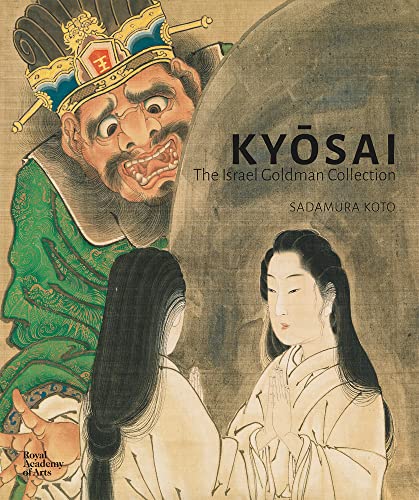
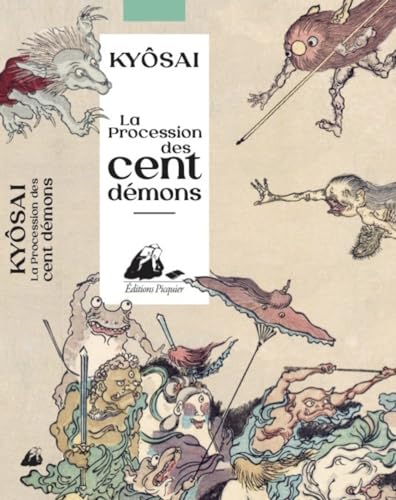
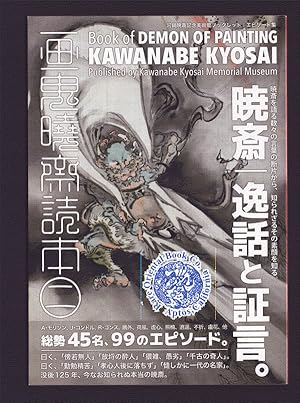
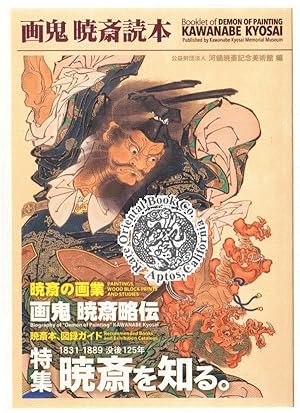

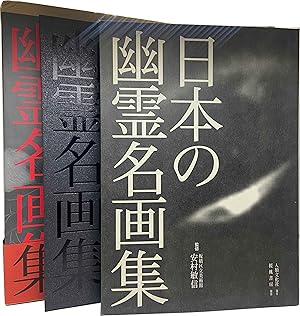
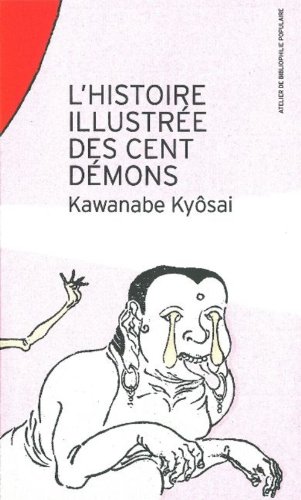
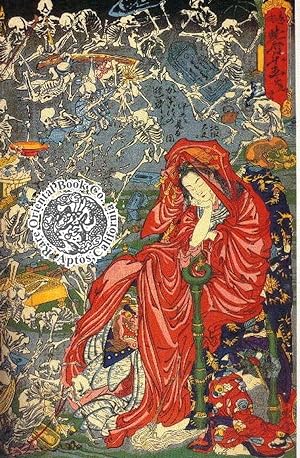
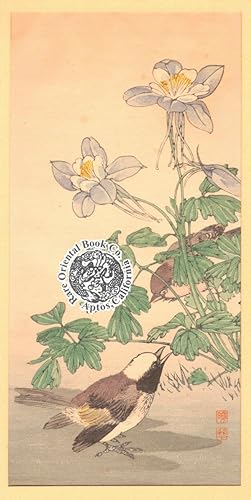
![Bild des Verkäufers für Irimasu Seizan [A Playful Print by Kyosai and Katsubunsai] zum Verkauf von Kagerou Bunko (ABAJ, ILAB)](https://pictures.abebooks.com/inventory/md/md30773496521.jpg)
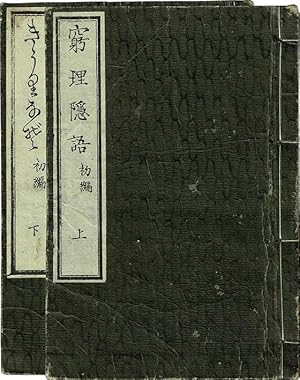
![Bild des Verkäufers für Kyosai Gadan [2 out of 4 volumes of Kyosai's Treatise on Painting] zum Verkauf von Keoghs Books](https://pictures.abebooks.com/inventory/md/md30233572355.jpg)
